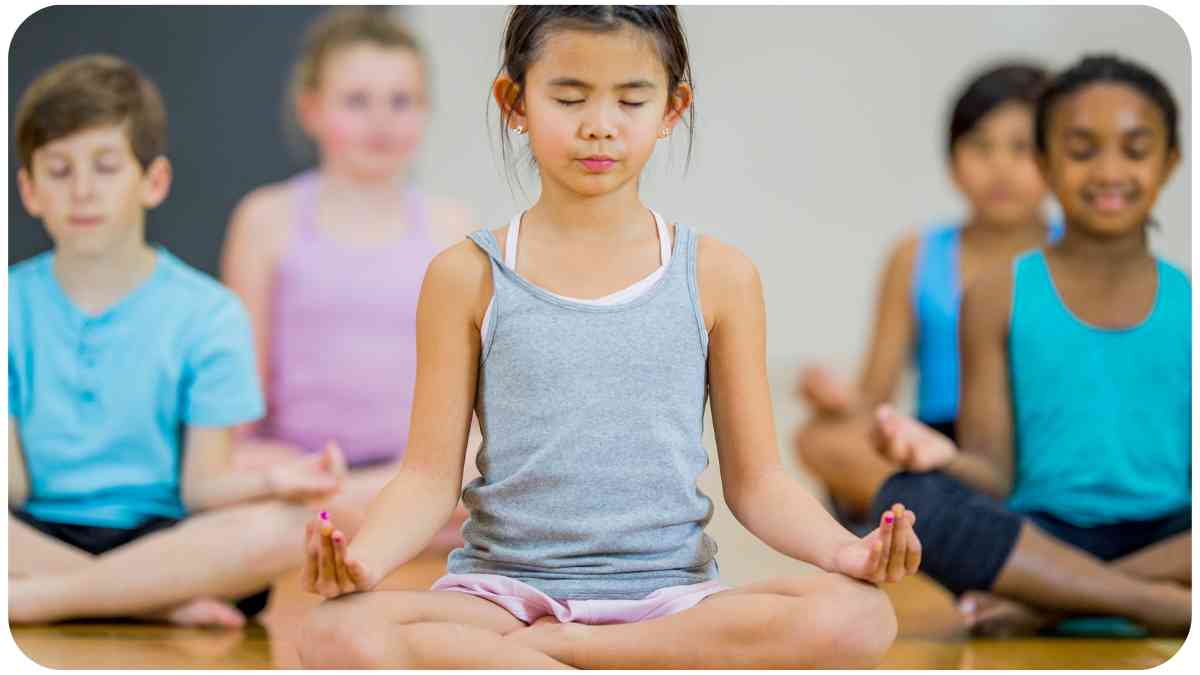In today’s fast-paced world, ensuring that our children get adequate and restful sleep is crucial for their overall well-being. However, many parents face challenges when trying to establish a bedtime routine that promotes relaxation and deep sleep.
This article explores the concept of calming nightly meditations for sleepy children, offering practical tips and techniques to help your little ones drift into a peaceful slumber.
| Takeaway |
|---|
| Establish a consistent bedtime routine that incorporates calming nightly meditations. |
| Understand common sleep issues in children and tailor meditation techniques accordingly. |
| Choose from a variety of meditation techniques, such as mindful breathing and guided imagery. |
| Address challenges like restlessness and short attention spans with practical solutions. |
| Explore real-life case studies to witness the positive impact of nightly meditations. |
| Integrate meditation into daily life for sustained benefits beyond bedtime. |
| Foster a calm sleep environment with tips like dimming lights and comfortable bedding. |
| Utilize recommended resources, including podcasts and apps, for additional support. |
| Answer common FAQs to guide parents in implementing meditation successfully. |
Understanding the Importance of Sleep for Children
Table 1: Common Sleep Issues in Children
| Sleep Issue | Description |
|---|---|
| Difficulty Falling Asleep | Insights into common challenges parents may encounter. |
| Night Wakings | Understanding why children may wake up during the night. |
| Restlessness | Tips for addressing restlessness before bedtime. |
| Short Sleep Duration | The importance of age-appropriate sleep durations. |
Ensuring a good night’s sleep begins with understanding the sleep issues your child may be facing. From difficulty falling asleep to frequent night wakings, Table 1 provides insights into common challenges and sets the stage for implementing calming meditations.
Explore the enchanting world of Frozen with yoga flows designed to melt away stress. These kid-friendly sequences combine fun and relaxation, making bedtime a magical experience for your little ones.
Benefits of Nightly Meditations for Children

Table 2: Comparison of Meditation Techniques for Children
| Meditation Technique | Description |
|---|---|
| Mindful Breathing | Focusing on breath to calm the mind and body. |
| Guided Imagery | Using visualization to create a calming mental image. |
| Progressive Muscle Relaxation | A step-by-step muscle relaxation technique. |
| Relaxing Sounds | Incorporating soothing sounds for a peaceful ambiance. |
Calming nightly meditations offer a range of benefits for children. Table 2 compares various meditation techniques, helping parents choose the approach that best suits their child’s temperament and preferences.
Creating a Calming Bedtime Routine
Table 3: Sample Bedtime Routine with Meditation
| Time | Activity |
|---|---|
| 7:00 PM | Dinner |
| 8:00 PM | Warm Bath |
| 8:30 PM | Story Time with Meditation |
| 9:00 PM | Lights Out, Soft Music, or White Noise |
A structured bedtime routine sets the stage for a peaceful night’s sleep. Table 3 provides a sample bedtime routine that incorporates calming meditation, making bedtime a relaxing and enjoyable experience for both parents and children.
Introduce your children to the world of mindfulness with 13 meditation methods designed just for them. These playful yet effective techniques cultivate focus and calmness, providing valuable tools for their emotional well-being.
Mindful Breathing Exercise
Table 4: Mindful Breathing Techniques for Children
| Technique | Instructions |
|---|---|
| Bunny Breaths | Inhale through the nose, exhale through the mouth. |
| Balloon Breaths | Visualize inflating and deflating a balloon. |
| Starry Sky Breaths | Imagine breathing in the calmness of a starry sky. |
Mindful breathing is a foundational meditation technique. Table 4 introduces simple and engaging mindful breathing exercises for children, promoting a sense of calm and relaxation.
Guided Imagery for Sweet Dreams

Table 5: Visualization Themes for Children
| Theme | Description |
|---|---|
| Enchanted Forest | Guiding children through a magical forest. |
| Ocean Adventure | Imagining a soothing journey under the ocean. |
| Cozy Cloud Retreat | Drifting off to sleep on a soft, cozy cloud. |
Guided imagery introduces children to captivating mental landscapes. Table 5 provides visualization themes that spark creativity and help children transition into a serene dreamland.
Ease anxiety in children through guided meditations that foster relaxation. These carefully crafted sessions empower kids to manage stress, promoting a peaceful and restful bedtime routine.
Progressive Muscle Relaxation (PMR)
Table 6: PMR Steps for Children
| Step | Muscle Group |
|---|---|
| 1. Tense and Release | Fists and Forearms |
| 2. Shoulders and Neck | Shrug shoulders, then release tension. |
| 3. Belly Squeeze | Tighten and relax abdominal muscles. |
| 4. Toes and Feet | Curl toes tightly, then release. |
Progressive Muscle Relaxation (PMR) is an effective technique for releasing physical tension. Table 6 breaks down PMR into child-friendly steps, making it easy for parents to incorporate into their nightly routine.
Incorporating Relaxing Sounds
Table 7: Popular Relaxing Sounds for Children
| Sound | Description |
|---|---|
| Gentle Rain | Mimicking the sound of raindrops. |
| Ocean Waves | Replicating the rhythmic sounds of the ocean. |
| Celestial Lullaby | Soft and calming melodies for relaxation. |
Adding soothing sounds to the sleep environment enhances the overall calming effect. Table 7 suggests popular relaxing sounds that contribute to a tranquil bedtime atmosphere.
Tips for Parents: Facilitating a Calm Environment
Table 8: Creating a Calm Sleep Environment
| Tip | Implementation |
|---|---|
| Dim the Lights | Create a relaxing ambiance with soft lighting. |
| Comfortable Bedding | Ensure your child’s bed is cozy and inviting. |
| Minimize Distractions | Remove electronic devices from the bedroom. |
| Establish Consistency | Maintain a consistent bedtime routine. |
Creating a calm sleep environment is essential. Table 8 provides practical tips for parents to foster a soothing atmosphere conducive to quality sleep for their children.
Addressing Common Challenges
Table 9: Troubleshooting Common Meditation Challenges
| Challenge | Solution |
|---|---|
| Restlessness | Try a variety of meditation techniques. |
| Short Attention Span | Start with shorter sessions and gradually increase. |
| Resistance to Meditation | Introduce meditation as a fun and enjoyable activity. |
| Difficulty Visualizing | Use props or drawings to aid visualization. |
Despite the benefits of meditation, parents may encounter common challenges. Table 9 offers practical solutions to address issues such as restlessness, short attention spans, resistance, and difficulty visualizing, ensuring a smoother meditation experience for both parents and children.
Introduce your little ones to the joys of yoga with beginner classes that focus on stretching and breathing. These gentle sessions cater to kids, encouraging physical activity and mindfulness in a playful setting.
Case Studies: Successful Implementation
Table 10: Before and After Sleep Meditation Results
| Case | Initial Sleep Challenges | Post-Meditation Progress |
|---|---|---|
| Case 1: Emily | Difficulty falling asleep, frequent night wakings. | Improved sleep onset, fewer night disturbances. |
| Case 2: Alex | Restlessness and resistance to bedtime. | Calmer bedtime routine, reduced resistance. |
| Case 3: Olivia | Short sleep duration and bedtime anxiety. | Extended sleep duration, relaxed bedtime. |
Real-life success stories provide inspiration and proof of the positive impact of nightly meditations. Table 10 showcases before-and-after results, demonstrating how meditation can address various sleep challenges in different children.
Integrating Meditation into Daily Life

Incorporating nightly meditations into your child’s routine is just the beginning. It’s essential to extend these practices into daily life for sustained benefits. Encourage mindfulness during daytime activities, such as mindful eating or brief breathing exercises during moments of stress. Consistency is key to establishing a lasting impact on your child’s overall well-being.
FAQs About Children’s Meditation
Table 11: Frequently Asked Questions
| Question | Answer |
|---|---|
| When to Start | Begin when your child shows interest and readiness. |
| How Long Each Session | Start with short sessions, gradually increasing. |
| Dealing with Resistance | Make it enjoyable; offer choices for meditation. |
| Combining with Other Activities | Integrate with bedtime routine or calming activities. |
Answering common questions about children’s meditation helps parents feel more confident and informed. Table 11 addresses concerns related to when to start, session duration, dealing with resistance, and integrating meditation into daily activities.
Take a journey from the new moon and back with creative visualizations designed for young minds. These imaginative practices instill self-compassion and provide a unique approach to meditation for children.
Conclusion
In conclusion, incorporating calming nightly meditations into your child’s routine can have a profound impact on their sleep quality and overall well-being. Understanding the importance of sleep, exploring different meditation techniques, and creating a soothing bedtime routine are key elements in this journey.
By addressing common challenges, learning from successful case studies, and integrating meditation into daily life, parents can foster a serene environment that promotes restful and rejuvenating sleep for their children.
Remember, each child is unique, so feel free to experiment with different techniques and tailor the approach to suit your child’s preferences. With patience and consistency, you can create a bedtime routine that not only ensures a peaceful night’s sleep for your little ones but also strengthens the parent-child bond through shared moments of relaxation and mindfulness. Sweet dreams await!
Further Reading
For additional resources on children’s meditation and promoting better sleep, consider exploring the following:
- Kids Meditation Sleep Stories Podcast
- Tune in to this podcast for soothing meditation stories designed specifically for children, promoting relaxation and peaceful sleep.
- Headspace: Better Sleep for Kids
- Head to Headspace for specialized content focused on improving sleep for kids. Explore guided meditations and sleep exercises tailored to children’s needs.
- Inner Peace Fellowship: How to Meditate
- Visit Inner Peace Fellowship for valuable insights on meditation techniques. Learn how to introduce meditation to children and cultivate a sense of inner peace.
FAQs
When is the right time to start introducing meditation to my child?
Start introducing meditation when your child shows interest and readiness. It’s essential to gauge their curiosity and create a positive and enjoyable experience.
How long should each meditation session be for children?
Begin with short sessions, gradually increasing the duration as your child becomes more comfortable with the practice. Tailor the length to their attention span and engagement level.
What if my child resists meditation?
If your child resists meditation, make it enjoyable by incorporating fun elements. Offer choices for meditation themes or use props to create an engaging experience.
Can I combine meditation with other bedtime activities?
Yes, you can integrate meditation into your child’s bedtime routine or other calming activities. Combining meditation with familiar rituals can make it a seamless part of their daily life.
Are there specific meditation techniques suitable for young children?
Yes, various meditation techniques are suitable for young children. Mindful breathing, guided imagery, and progressive muscle relaxation can be adapted to suit their age and preferences.

Hello, my name is Hellen James! I am a yoga teacher and writer who loves to share information about how you can achieve a more fulfilling life. I have been practicing mindfulness, yoga, and meditation for over 10 years. My passion for these practices has led me to teach them to others.

